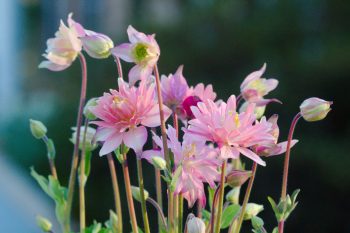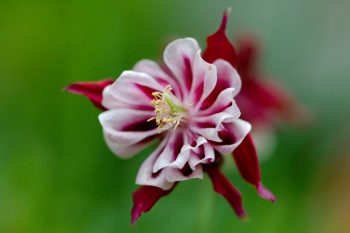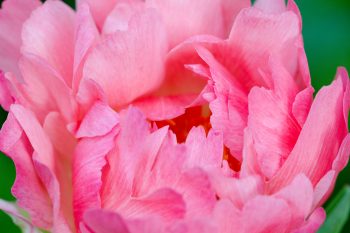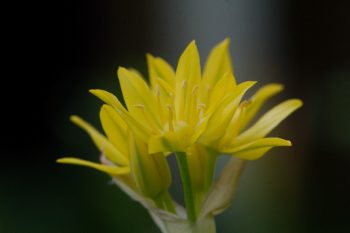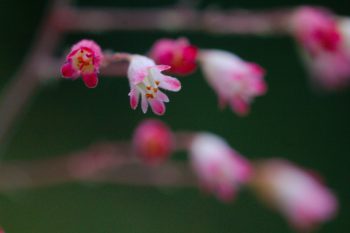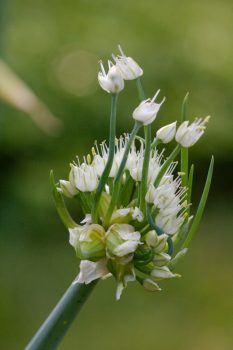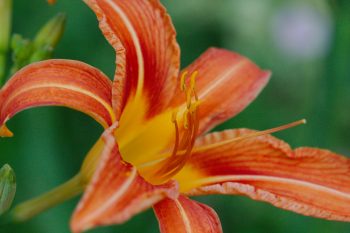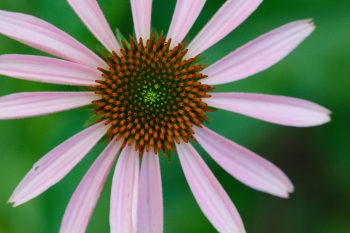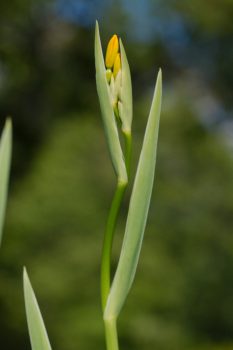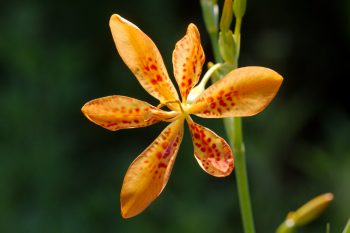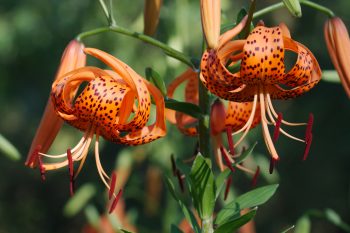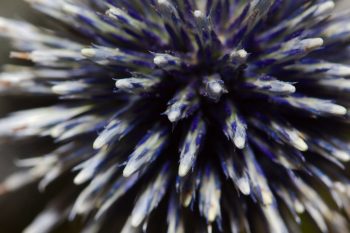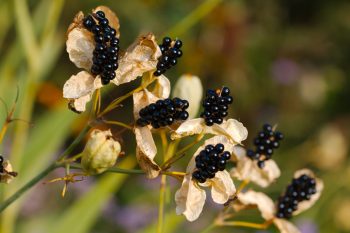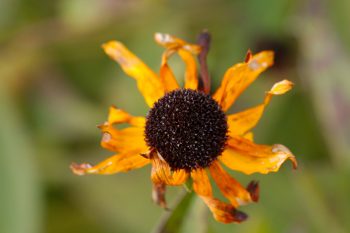Cathy bought two columbine plants (Aquilegia) on Sunday and this is one of them. It’s not the standard, native Aquilegia canadensis with its drooping flowers and distinctive spurs. The label had no information on it beyond Aquilegia so I don’t know what the variety name is or anything. It’s quite pretty and I photographed it in the late afternoon sun, to help light up the delicate pink petals. We have a fair amount of columbine in the yard, although most of it is self-seeded volunteers and is a dark, maroon color. I doubt the seeds from this will be anything like it is, but you never know, maybe we’ll start getting some new varieties around the yard.
Tagged With: Hardy Perennial
Pink Columbine
Lily of the Valley
The lily of the valley (Convallaria majalis) is starting to bloom. This is a great, little ground cover once it gets itself established. That can take a little while and they aren’t cheap when you buy them from the garden center a few pips at a time. They also have a tendency to “migrate” in the garden. In our back yard they are around the two smaller maple trees that we still have. Over the time we’ve been here they have expanded and died out in the central part of the bed. I wish you could make it “turn around” and head in the other direction but short of digging it up and physically turning it around, that’s not really possible.
The flowers don’t last very long but while they are blooming they are really pretty. Note that all parts of the plant are poisonous, containing cardiac glycosides, so don’t try to use them as a salad green. I don’t think that’s something I’d have thought to try anyway.
Columbine
The columbine (Aquilegia canadensis) is really coming into bloom now in our garden. We have a few different varieties and I won’t swear that they are all this species (in fact I don’t think they are). But this one, I think probably is. It’s one of two that have flowers with a fuchsia or slightly purple color in their flowers. The other one is darker, almost tending towards a brownish red. It also has slightly more double white parts. They are both nice in their own way, and I’m pretty happy with this self seeding through out the garden. It doesn’t go out of control, like some self-seeders tend to do, so I don’t really mind.
Peony ‘Coral Sunset’
This is one of three peonies that I planted in 2014, named ‘Coral Sunset’ that are growing will in the back garden. I’m a big fan of peonies and if I had a lot of space I might devote and entire garden room to them. There are both herbaceous and woody stemmed peonies and the are both worth growing. They do take a while to get established but they don’t really require much care. The reward in the huge, brightly colored flowers every spring. There is a nice peony garden at Seneca Creek State Park, if you are interested. I haven’t had a chance to go this year and it isn’t looking like I will, but it’s worth a peek, if you can get there when they are in bloom.
Allium moly
Allium moly, commonly known as golden garlic, is a pretty, ornamental flowering onion with bright yellow flowers. I have this growing long side our front walk, although it has been surrounded by other plants so it isn’t as prominent as it was when it was first planted. I really should have more of this. It blooms after the majority of bulbs are done, so helps fill a gap in the blooming cycle. It’s also a lovely, bright yellow, which is hard to miss. I have it growing next to a small Siberian iris called ‘Eric the Red’ and the two go very well together, with purple and yellowing being a really good combination. They are also on the small side for their respective genuses. Highly recommended.
Adiantum pedatum (Northern Maidenhair Fern)
I’ve posted pictures of this fern before and I’ll probably do so again. It’s a pretty fern and worth growing, if you have any interest in ferns. I actually have it in a less than ideal spot that gets pretty much full sun from about noon onwards. It would be happier in full shade. The Missouri Botanical Garden page on this plant says, “High summer heat may cause fronds to brown by mid to late summer, particularly if good soil moisture is not maintained and/or plants are grown in too much sun.” Yep, that happens here. I really need to move it, or at least take a piece or two of it to grow in a better location. It does amazingly well in the sun, but it could be so much happier.
Heuchera sanguinea
We’ve had coral bells (Heuchera sanguinea) growing in our garden and in containers pretty much since we have been able to have a garden. It’s not the sturdiest of plants and we’ve had to replace them from time to time. I may be forgetting something but I think this is currently our only plant, growing in a container in the driveway. It’s fairly happy, probably because the containers get watered more regularly throughout the summer than the in-ground plantings. Also, although this gets a bit of direct morning sun, it’s in bright, open shade by early afternoon so it doesn’t bake. It seems to be happy and it blooms quite freely, which is nice.
Asiatic Lilies
We have some Asiatic lilies in the bed where there used to be an oak tree in front of our house. The oak has been gone for long enough that I don’t remember when it was cut down (and I don’t feel like searching through my journal to find out). The lilies are doing quite well and they are surrounded by other plants which seems to have kept the deer and rabbits from eating them, which is nice. As you can see, they are a very hot orange and are quite spectacular. The tiger lilies, which won’t bloom for a while yet, are much taller and more obvious. These blooms are only about 18 inches from the ground and face upwards, which is terrific.
Egyptian Walking Onion
I planted a few of these years ago at our old house, after having taken a few bulblets from the top of some growing in a garden we visited. A few years ago I decided to get rid of them, but that’s easier said than done. This one is growing in the grass outside the fenced herb garden that I made a while back. I think we need to be a bit more ruthless in pulling them up. They are interesting, though, and if we had a lot of space, I’d have a bunch. The stems, which are really tubular leaves, have flower clusters at the top. Then bulblets form and sometimes there are flower clusters growing from those bulblets. When the top becomes heavy from the size of the bulblets, the whole plant falls on its side, those bulblets take root and new plants spring up. It’s that spreading action that gives rise to the “walking” part of their name. Anyway, if you’d like some, feel free to ask and I’ll give you a few bulblets and you can start your own colony.
Day Lily
The day lilies are coming into bloom. These are great plants and easy to grow. They like full sun but are quite tolerant of a bit of shade (with a bit of reduced blooming, though). You often see them growing in ditches along road sites in the country. Those that we have are from a very small town that no longer exists in rural Pennsylvania. The houses are all gone, except for a few stone basements slowly being filled by the passing of time. around one of them is a huge patch of day lilies. They are in fairly deep shade, so don’t bloom profusely, but they are happy and continue spreading their roots. I dug up a few many years ago and they really responded to the sun and never fail to satisfy.
Coneflower
There are quite a few really amazing coneflower (Echinacea purpurea) varieties now and if I had the space and the time and the money, I’d consider a collection of the as one aspect of a large garden. They vary in color from the “standard” pinkish-purple bracts and with orange spikes, as seen here, to all sort of oranges, yellow, and darker purples. They flower shapes vary, as well, and they are all lovely. Sadly, there are enough plant-eating insects that enjoy them that they don’t often last in pristine condition. Photographing them in their prime means getting them when the flowers first open, because the bracts get holes in them almost immediately. Still, they provide color in a time when not a lot is blooming.
Blackberry Lily (Iris domestica)
We’re in that in between time, after the spring and early summer bloomers have finished up but before the late summer flowers have really started in earnest. There are a few things in bloom, including the day lilies and the buddleia are starting to bloom and attract bees and butterflies. The gooseneck loosestrife (Lysimachia clethroides) has been blooming but doesn’t add a lot of color, having white flowers. Also, I don’t care how desperate you are for blooms, I don’t recommend you put this anywhere near your garden, unless that’s all you want. Pretty soon these buds will begin to open. They are Iris domestica, the blackberry lily, which until recently also went by the name Belamcanda chinensis and sometimes known as leopard lily. These have self-seeded around the yard but are well within the limits of what’s easy to control, if they come up where you don’t want them. I highly recommend them for any sunny garden.
Blackberry Lily (Iris domestica)
The blackberry lilies (Iris domestica and formerly Belamcanda chinensis) have started to bloom in the garden. We originally got this when I collected some seeds and planted them at our old house. We brought some here with us in 2006 and they have really taken hold. We sprinkle the seeds around and let them grow where they will. They aren’t nearly so aggressive as to be a problem and they are so pretty. I had a picture of the buds recently but this is the flower. They open in the morning and each individual flower only lasts a day, but they are born in profusion and soon we’ll have dozens of them in bloom, scattered around the yard.
Lilium lancifolium (Tiger Lily)
The tiger lilies are blooming and they are really spectacular this year. My dad had these growing in his garden and from time to time we would take the little bulbils that form in the angle between the leaves and stem on these plants and we’d put them in our garden. We continued that process, with bulbils from our own plants and now we have a pretty good number of them around the yard. These are growing in the small bed where an oak tree once grew. That tree was dying when we bought the house and has since been removed. There are daffodils there and Cathy often puts annuals in the center of the bed, but these lilies are growing towards the back (the house side). They are over six feet tall and quite striking, with racimes of large, orange, downward-facing flowers.
Cathy In The Back Garden
With my back still bothering me, I stayed home today. I did put in a little time at work, mostly a long phone call to discuss a proposal that is being written for a project that includes a web site. When Cathy got home from work I asked if I could take her picture for my photo of the day. She agreed and I took almost two dozen shots of het with her flowers. Most obvious are the Rudbekia (the Black-eyed Susans). There is also orange and yellow butterfly weed Asclepius tuberosa) on the right. In front of that is the pale pink spider flower (Cleome). There are other annuals in pots and there is the red teapot lower down.
Lobelia cardinalis
This red Lobelia cardinalis is growing under the cherry tree at the north end of our yard. It’s really bright and I thought it was worth getting a picture of. With my back still bothering me I wanted to be really careful getting behind it so I could get the picture without having to bend over and with the trunk of the cherry tree available for me to brace the camera against. I was very carefully watching where I was stepping so I wouldn’t trip but about half way back, all of a sudden, I whacked my head against a ceramic wren nesting box hanging from a branch of the tree. I didn’t quite fall but it did my back no favors. Still, I got the picture. Coming back out I was even more careful where I walked and I kept an eye on that nesting box.
Sea Holly
By the time I got home this evening I didn’t feel like going out looking for something to photograph. Later in the evening, as is usually the case, I wished I had, because it meant I had to find something indoors to photograph. If finding something new and interesting to photograph in the yard is a challenge, how much more so is that true in the house. Fortunately there was a vase of flowers on the dining room table and in it were the blue and grey balls of Eryngium planum, better known as sea holly. These are interesting flowers. We had some in our garden in Gaithersburg and I should plant some here. The blue would be especially nice as a contrast to all the yellow-orange of the black-eyed Susan flowers.
Lobelia siphilitica (Blue Cardinal Flower)
This is a really nice plant. Blue cardinal flower, Lobelia siphilitica, is an easily grown, herbaceous perennial, native to eastern North America and hardy to USDA zone 4. It needs fairly moist soil and does better here in part shade, where the ground doesn’t dry out so much, or in full sun in pots where it gets regular watering. It blooms over a fairly long period, which is always appreciated. One thing I didn’t know about it is that the species name of siphilitica is from “a prior medicinal use of the plant in the treatment of venereal disease.”
It does well in our garden and we have it scattered around. This particular plant is growing in a container on the driveway with black-eyed Susans behind it. Blue and yellow is always a good combination in the garden and with yellow being so prominent in ours, adding that touch of blue is great.
Blackberry Lily (Iris domestica)
The flowers on this plant, Iris domestica, the blackberry lily, don’t really give much clue to their common name. When they go to fruit, however, it’s a little clearer where that comes from. They do have a certain blackberry-like look to them. The flowers are a bright orange and are really lovely. The leaves are very iris-like and are beautiful, sculptural fans of varying shades of green. In fact, I’d be tempted to grow these even if they leaves were all they provided. But the flowers are welcome and I like the fruit, as well. We scatter these fairly liberally around the garden and they are now coming up in various places. They aren’t so aggressive that we worry about them taking over, either, which is nice.
Black-eyed Susan
The black-eyed Susans in the yard are mostly finished now. The petals are drying up and falling off. Soon there will be nothing left but the stalks and seed heads. We generally leave those for the birds to eat during the winter. They seem to be pretty popular with the gold finches, in particular. This isn’t as good a picture as I hoped it would be. It was fairly late in the day and I didn’t bother to get my tripod, so I wasn’t able to get the depth of field that I should have. Still, I like the colors quite well. This is what autumn is about.

